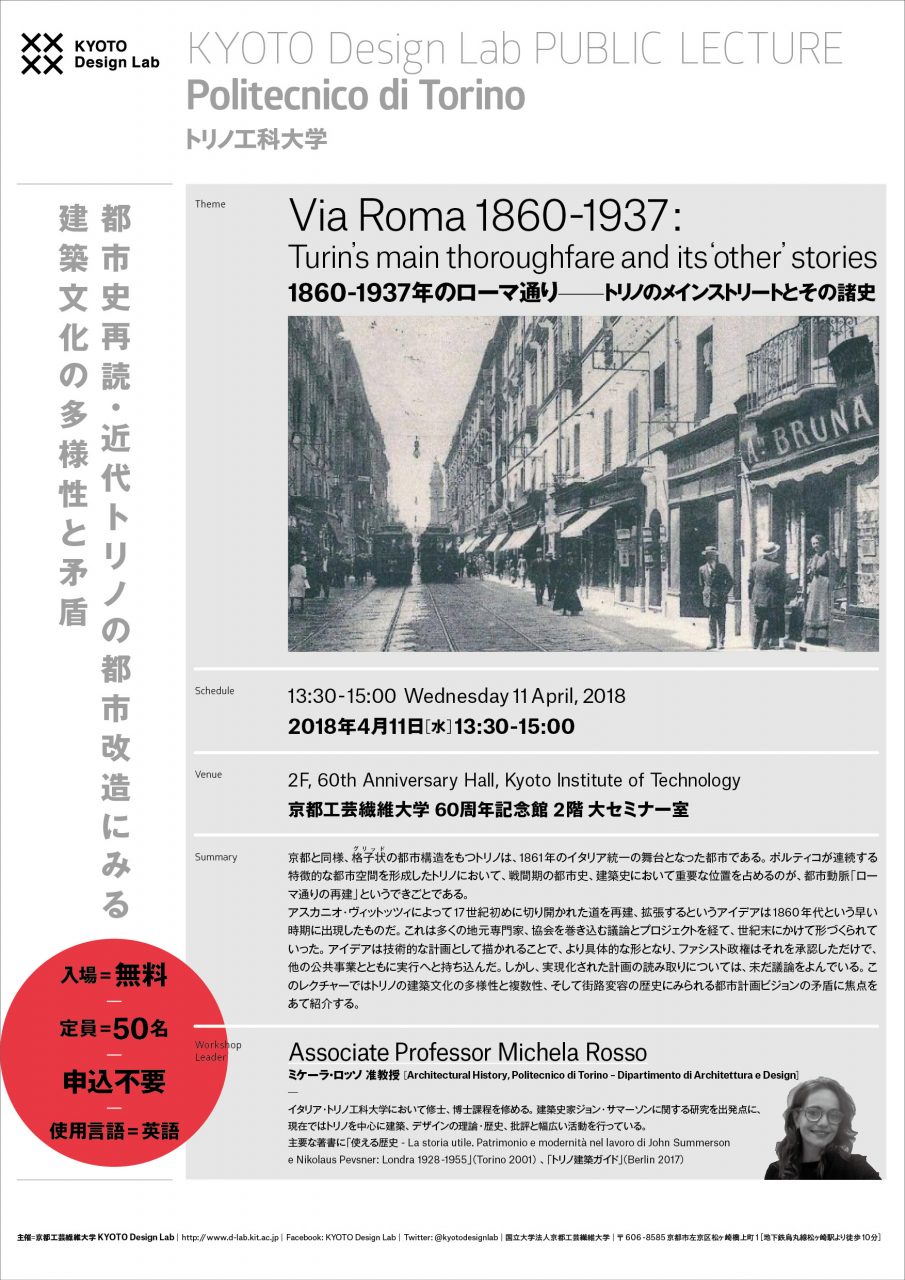KYOTO Design Lab[D-lab]は、下記の日程で、トリノ工科大学 建築・デザイン学部で建築史を専門とするミケーラ・ロッソ准教授によるパブリックレクチャー「1860-1937年のローマ通り──トリノのメインストリートとその諸史」を開催します。
入場無料、申込不要のレクチャーです。ぜひご参加ください。

1860-1937年のローマ通り──トリノのメインストリートとその諸史
日時|2018年4月11日[水] 13:30-15:00
会場|京都工芸繊維大学 60周年記念館2F 大セミナー室
講師|ミケーラ・ロッソ 准教授[トリノ工科大学]
定員|50人
入場|無料、申込不要
使用言語|英語
主催|京都工芸繊維大学 KYOTO Design Lab
概要
京都と同様、格子状の都市構造をもつトリノは、1861年のイタリア統一の舞台となった都市である。ポルティコが連続する特徴的な都市空間を形成したトリノにおいて、戦間期の都市史、建築史において重要な位置を占めるのが、都市動脈「ローマ通りの再建」というできごとである。
アスカニオ・ヴィットッツィによって17世紀初めに切り開かれた道を再建、拡張するというアイデアは1860年代という早い時期に出現したものだ。これは多くの地元専門家、協会を巻き込む議論とプロジェクトを経て、世紀末にかけて形づくられていった。アイデアは技術的な計画として描かれることで、より具体的な形となり、ファシスト政権はそれを承認しただけで、他の公共事業とともに実行へと持ち込んだ。しかし、実現化された計画の読み取りについては、未だ議論をよんでいる。このレクチャーではトリノの建築文化の多様性と複数性、そして街路変容の歴史にみられる都市計画ビジョンの矛盾に焦点をあて紹介する。
講師略歴
ミケーラ・ロッソ 准教授[トリノ工科大学 建築・デザイン学部]
イタリア・トリノ工科大学において修士、博士課程を修める。建築史家ジョン・サマーソンに関する研究を出発点に、現在ではトリノを中心に建築、デザインの理論・歴史、批評と幅広い活動を行っている。主要な著書に「使える歴史 – La storia utile. Patrimonio e modernità nel lavoro di John Summerson e Nikolaus Pevsner: Londra 1928-1955」(Torino 2001) 、「トリノ建築ガイド」(Berlin 2017)
KYOTO Design Lab will hold the public lecture “Via Roma 1860-1937: Turin’s main thoroughfare and its ‘other’ stories” by Michela Rosso (Politecnico di Torino).

Via Roma 1860-1937: Turin’s main thoroughfare and its ‘other’ stories
Date: 13:30-15:00 Wednesday 11 April, 2018
Venue: 2F, 60th Anniversary Hall, Kyoto Institute of Technology
Lecturer: Michela Rosso [Associate Professor of Architectural History, Politecnico di Torino]
Seating Capacity: 50
Language: English
Admission free
Organized by KYOTO Design Lab, Kyoto Institute of Technology
Summary
Turin is a “grid city” as same as Kyoto and it became a stage of Italian unification “resorgimento” in 19th century. The centre of the architectural and urban history of Turin in the interwar years is the reconstruction of via Roma, the city’s major artery, a story for which it is necessary to go back in time.
The idea of widening and rebuilding the street opened by Ascanio Vittozzi at the beginning of the 17th century appears as early as the 1860s. It comes into being at the turn of the century through a series of projects and discussions that involve a number of local professionals and associations.
Alongside the approval of the City’s Master Plan, the idea finds a more concrete definition with the drawing of a technical project. The fascist regime does nothing other than accept and put into practice this project, as it does with other public works.
However, the translation of the plan into a built form is not devoid of disputes…
The lecture will highlight the the plurality and diversity of Turin’s architectural cultures and their conflicting visions throughout the history of the street’s transformation.
Lecturer
Associate Professor Michela Rosso [Politecnico di Torino – Dipartimento di Architettura e Design]